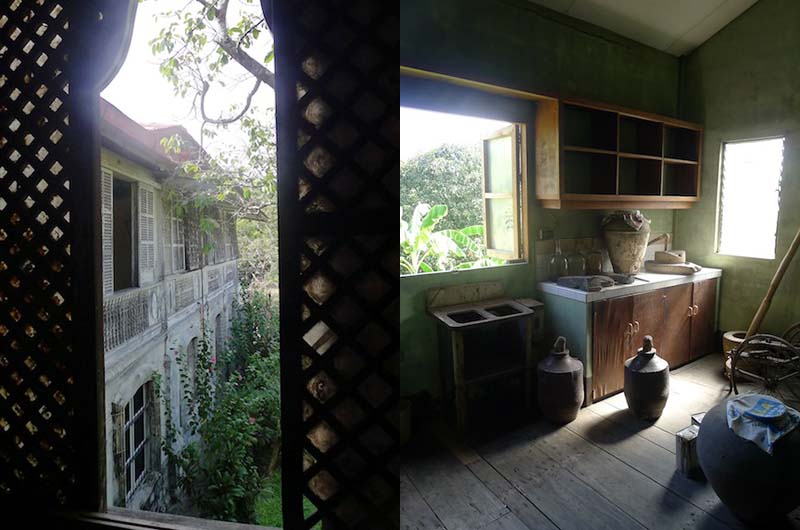 |
| The Ruins in Talisay is a sugar baron’s Taj Mahal to a lost lover. |
Talisay City (7.3 kilometers from Bacolod) was next on our list of the media familiarization tour of the Western Visayas region. This city was the birthplace of the sugar industry of the province. Who would have known?
What is known today is the reason why people troop to this city 7 kilometers from Bacolod is to visit its attractions. Numero uno in the list would be The Ruins. Of course, lists may vary and to some, a more “complete” house with everything in it well preserved would be more interesting than the skeletal structure of a building.
 |
| The grand staircase & the living room |
Talisay has several of those as well—well-preserved ancestral houses, but what makes The Ruins interesting? Lucky for the heirs, they found something to tickle everyone’s fancy—a love story. Talisay’s history of sugarcane and war would have to take cameo roles woven into the romantic storyline of the Lacson mansion.
The characters: Mariano Ledesma Lacson as the sugar baron; Maria, the wife, a Portuguese lady from Macau; and their 10 children. The setting: Talisay, in a 440-hectare sugar cane plantation.
 | |
|
 |
| Not a tree but a tower |
The Ruins is referred to as the Taj Mahal of the region, once a stately mansion in Neo-Roman architectural design built by a man in love, Mariano, as a memorial to a lost inamorata, Maria from Macau. This was in 1911.
 |
| European influences on the arches & columns, with nautical representations by form of shells adorn the rooftop. |
Traveler Mariano met Maria in Macau and fell in love. The love affair bore ten children but tragedy struck while Maria was on her 11th pregnancy. Mariano lost both mother and child.
Heartbroken, the sugar magnate built a European influenced mansion at the center of the 440-hectare plantation in honor of Maria. A room for each offspring, but once married, the child must leave the house.
 |
| The heir running The Ruins as a Talisay attraction—Raymund Lacson Javellana |
It was during the war that the mansion was intently set on fire by the guerillas. This was to prevent the invading Japanese soldiers from using it as headquarters.
The remnants of the glorious past that we see today—the skeleton of a strongly constructed “temple” that withstood three days of fire, misuse and abandonment.
In 2008, after rehabilitation, the Structural Ruins of Don Mariano Lacson’s House was opened to the public as a museum. It peaked in popularity when one of the tour guide’s spiel went viral on the net.
There are other ancestral houses that have become historical landmarks in Talisay, like the
1880 Gen. Aniceto L. Lacson Historical House. The design is fusion of Filipino, Chinese and Spanish styles, and became the Malacanan of the Palace of the short-lived Cantonal Republic of Negro in 1889, in which Gen. Lcson was the (first and only) president.
Of the many ancestral houses in the city, we got to tour one—the Tana Dicang Lizares Ancestral House. Commonly referred to as Balay ni Tana Dicang (short for “Kapitana”. She took the title when his husband, the former kapitan, passed away), the well-preserved 1880 structure breathes of old world sophistication.
 |
| The façade of Balay ni Tana Dicang, ang bahay na bato |
 |
| (Left) A carosa. The affluent take part in processions showcasing their santo. (Right) The staircase landing. |
 |
| A grand staircase for a grand home. A detailed carving on the balusters. |
The Bahay na Bato’s size and grandeur is a visible testament of what upscale Talisay living was. A product of the couple who engaged in sugar production in 1875. By 1883, the two-level, 6,000-ssquare meter Spanish- Filipino colonial residence was home to the Lizares family for 117 years.
 |
| The receiving area and a view of the living room. |
Neat and organized, original furniture and decorations all in pristine order, the elegant balay of Tana Dicang exhibits an image of a home still in use.
 |
| Fit for formal entertaining, the wide sala of the balay. |
Perhaps it’s the spirit of the kapitana that still roams the halls of her former residence? There may be some truth to these rumors. The tour guide relates that there are days when the place reeks. It is a sign that she does not favor the presence of the “visitors” in her home. She must have liked our group.
 |
| The family dining room. It was said that nobody should be late when dinner is called. |
 |
| When rang, dinner is served. The other bell must be have been used to call the help. |
 |
| (Left) The view from the kitchen window. (Right) The kitchen. |
We left her a good impression. With that in mind, we head off to our next stop—Bacolod City.
Special thanks to DOT Region VI for hosting the Davao Media Familiarization Tour, and to Cebu Pacific (with direct flights to and from Davao City to Bacolod every Tuesday, Thursday, and Saturday).
For more travel & lifestyle stories, visit http://jeepneyjinggoy.blogspot.com/ and http://apples-and-lemons.blogspot.com/
Published in the Sun.Star Davao newspaper on April 4, 2015.



















CONVERSATION